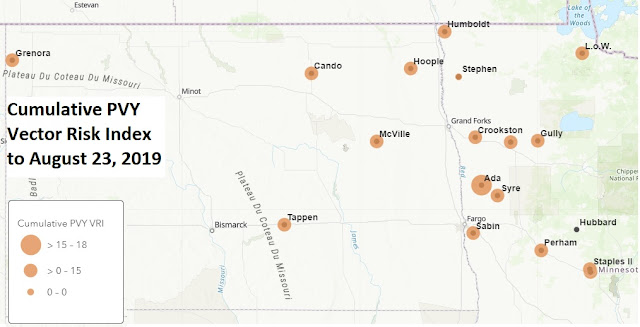Trap Catches Identified to August 21, 2020.
We had another big week for aphid vector numbers, with very similar numbers to last week. A total of 287 vectors were recovered from 15 sites reporting. In fact, with this week's catch, we've caught up with 2019 and are pretty much at the same levels, but with different levels at different sites....
A number of efficient vector species were recovered from most locations. Green peach aphids were found in Sabin, soybean aphids had a large flight with large captures at several locations. There seems to be high numbers of thistle aphids this year and populations of damson-hop aphids have developed as well this year. Populations of potato aphids persist and the small grain aphids (bird-cherry oat, corn leaf and English grain aphids) continue to be well-represented in trap catches. Because many of these are efficient vectors, the PVY Vector Risk Index has risen this week to also be pretty much the same as this time last year.
Many seed fields are being vine killed and harvested. But remember, aphids will continue to probe any green plant material in the field, so inoculum can be moved until plants are killed.
Hope harvest goes well, keep an eye on the fields...
If you have a field where Colorado Potato Beetle aren’t being controlled by insecticides, please let us know. We’d like to get samples of that population to test for insecticide resistance. Contact Ian MacRae at 218-280-9887.
As always, keep on scouting!
Click on any image below for full-scale version.
Cumulative PVY Vector Risk Index to August 21, 2020.
Cumulative PVY Vector Risk Index to August 23, 2019 season (for comparison)



